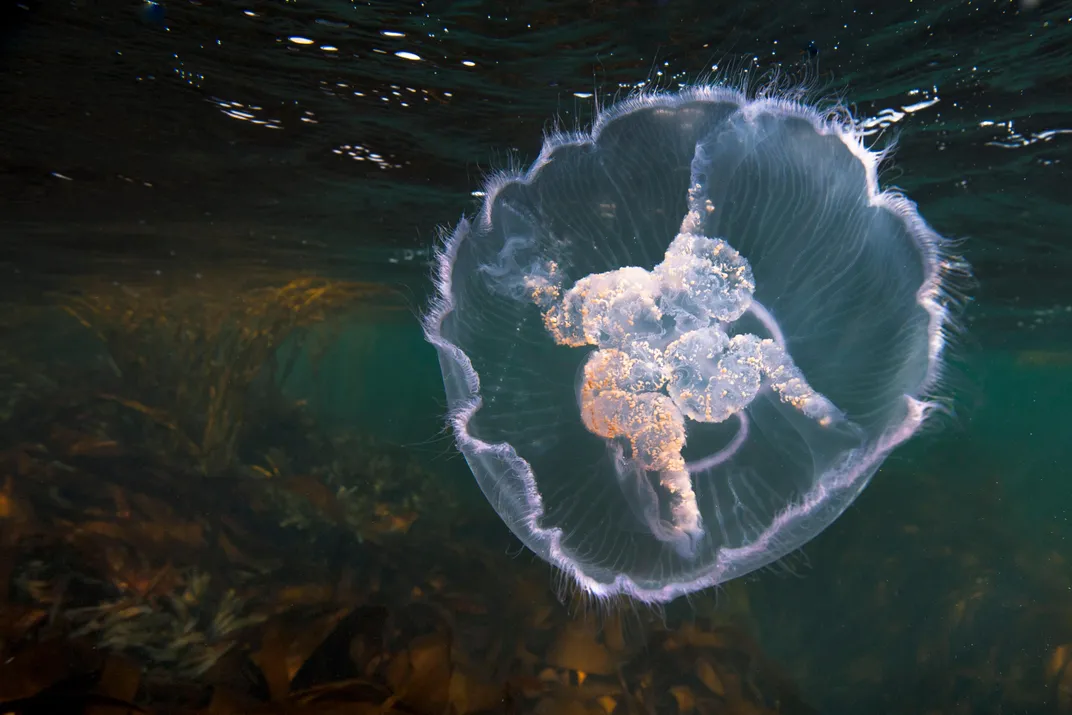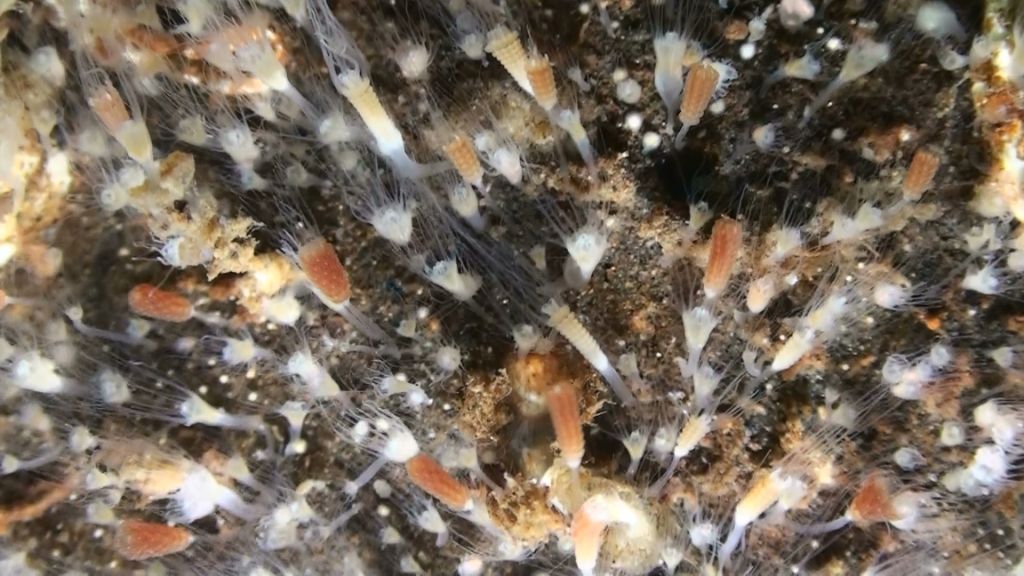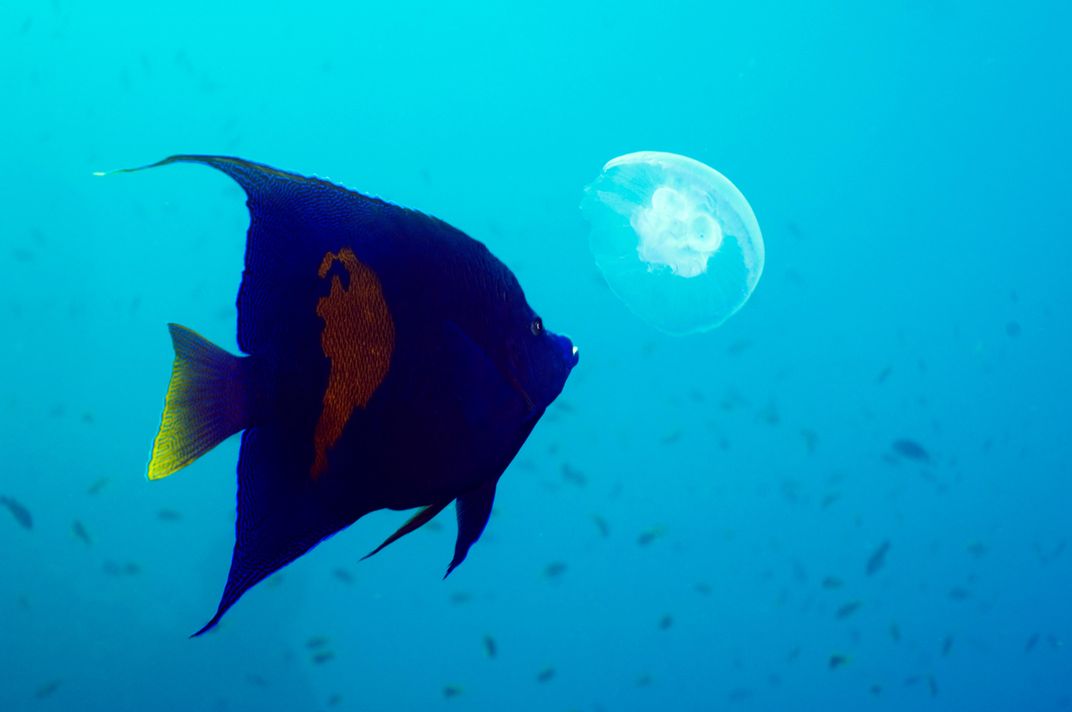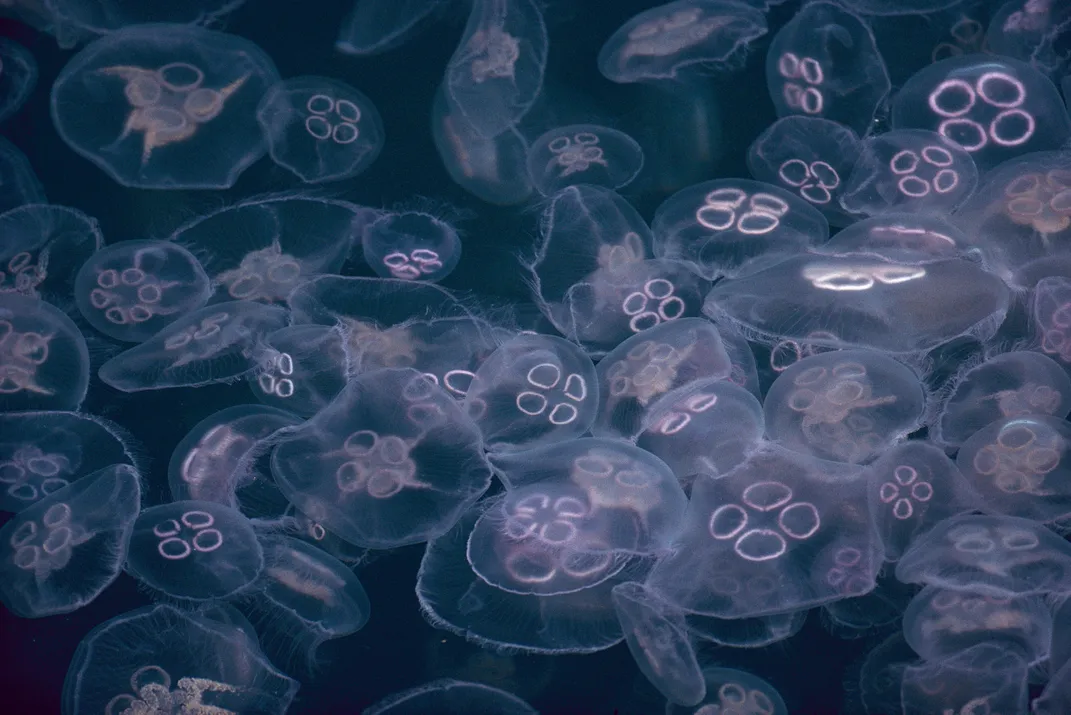Big Moon Jelly Blooms Tied to New Dock Construction
A floating pier installed off Japan led to a four-fold increase in baby jellies, offering a solid link between structures and blooms
/https://tf-cmsv2-smithsonianmag-media.s3.amazonaws.com/filer/0d/22/0d22e700-522b-43fc-862f-0363e12aff0b/42-18498813.jpg)
Jellyfish blooms have been making waves over the last few decades, with reports that conglomerations of these gelatinous creatures seem to be on the rise. Scientists debate whether blooms are becoming more common globally due to human activities or whether people are simply noticing them more as humans increasingly engage with the sea. But many agree that in certain areas—especially in enclosed waters near harbors—large jellyfish blooms are becoming more frequent, and these blooms tend to be dominated by a certain species: the moon jelly.
“If any species has increased, moon jellies definitely have," says Jennifer Purcell, a marine scientist at Western Washington University in Bellingham. A moon jelly (Aurelia aurita) looks like a delicate, transparent UFO with four petal-like gonads on the top of its bell and a trail of short, thin tentacles. The venom of moon jellies isn’t very powerful, so their stings aren’t a danger to people. But moon jellies are relatively large, reaching up to almost 16 inches wide, and their unpredictable blooms can be massive beyond imagination. One bloom in Japan's Uwakai Sea in 2000 contained an estimated 583 million jellyfish along 62 miles of coastline, concentrated in an area of less than 1.5 square miles.
These big blooms of jellyfish can create big problems. They've caused power plants to go offline when the intake water, intended to cool down hot equipment, gets loaded with jellies that clog the machinery. They fill up fishermen's nets so that they catch "few fish but large numbers of jellyfish," says Shin-ichi Uye, a jellyfish biologist at Hiroshima University in Japan. "They say being a fisherman isn't a good job anymore." And the jellyfish compete with larval fish and small schooling fish for their shared food source, plankton, potentially suppressing the populations of more desirable species.
While the commonly blamed causes for jellyfish blooms—warming water, pollution and overfishing—are slow and persistent, blooms themselves are not. What could trigger such an enormous influx of jellies? Since moon jellies only live for one year, it could be linked to their reproduction and lifecycle. Most baby moon jellies are born during the winter, when the jellies are in their polyp stage. Unlike the familiar drifting medusa phase, jellyfish polyps attach to a hard surface with their tentacles facing outward like a sea anemone. From this stable position, they release baby jellies, called ephyrae, into the water.
Hard structures in marinas make a perfect habitat for these polyps because they offer lots of space to settle, shade from the sun and few predators. It logically follows that new dock or pier construction should cause an increase in moon jellies and create blooms. But this idea hadn’t been tested experimentally until Uye and his colleagues found a unique opportunity: the addition of a new floating pier in the Kuba harbor of Hiroshima Bay. In the winter before the pier was installed, they collected, counted and measured baby jellies weekly at Kuba. They did the same at Ogata, a nearby port with similar conditions but without new pier construction plans.
On April 19, 2010, the Hiroshima Prefectural Port and Harbor Bureau towed and moored the new pier to four pilings in Kuba harbor. For the next two years, the scientists studied how jellyfish density changed as a result of the construction. In addition to their weekly ephyrae collection in both ports, they photographed the underside of the Kuba dock every other week to count the number and size of attached polyps—the longer the polyp, the more ephyrae it’s able to produce. The team also collected environmental data for both ports, such as water temperature, salinity and clarity.
The results, published last month in the Journal of Oceanography, showed that the number of baby moon jellies present in the dockless Ogata port stayed constant year over year. But in the year after the dock installation at Kuba, the number of ephyrae that moved from the port out to Hiroshima Bay and into the greater Sea of Japan increased more than four-fold—from 5.7 million to more than 25 million. Once at sea, the ephyrae join other moon jelly populations spawned from different ports, swarm, grow and die in the fall, after they release larvae that develop into new polyps.
But in the third year, the number of ephyrae in Kuba port decreased to pre-pier levels—a fact not published in the paper but relayed to Smithsonian.com by Uye. That's because there was new competition for space on the pier. Barnacles, mussels and other tunicates colonized the pier’s underside, which prevented as many polyps from settling in. This suggests that it's mostly brand-new construction that drives huge blooms, with older construction causing just small increases in jellyfish numbers.
Before this work, the connection between human structures and jellies had been pieced together across many individual studies. At ports the world over, divers observed tiny polyps, less than a couple millimeters long, growing on artificial structures. Field experiments showed that they prefer artificial structures to more natural surfaces, and that polyps seem to produce more ephyrae in disturbed environments with fewer predators and more nutrients. Removing human-made structures caused jellyfish populations to drop. But there was no study providing a link between more structures and more jellies—until now.
“This is the first really solid quantitative study showing that new floating structures can lead to increases in jellyfish density,” Allen Collins, curator of jellyfish at the National Museum of Natural History, wrote in an email. “It is an excellent contribution to our understanding of jellyfish blooms.”
That doesn't mean the case is closed, however. Rob Condon, a jellyfish ecologist at the University of North Carolina in Wilmington, says that while the study is valid on a local scale, "I definitely wouldn't say that it is something that can be extrapolated to an entire region or in a global sense." He points to evidence that jellyfish populations oscillate globally every 10 or 20 years, and that people see increases in blooms when those oscillations are on the upswing. Without a longer data set, there’s no real way to separate the effects of those oscillations from those caused by new construction.
However, Purcell holds that the results do apply to other moon jelly populations around the world because of their ubiquity and adaptability. The various species and subspecies of moon jellies, often only distinguishable by their DNA, are found in every ocean and behave similarly wherever they are found—including their preference for harbors. "[Their polyps have] been found all around the world on these kinds of structures," she says. She suspects that new construction in other locations would form blooms not unlike the one studied by Uye.
If new construction does in fact drive jellyfish blooms, there may be ways to prevent them by limiting polyp growth on piers. The natural predators of moon jelly polyps, such as some species of snails and crustaceans, are not often found in ports. Introducing them may prevent jellyfish blooms, says Uye, although he concedes that it would be a difficult solution to implement in a wide natural area. Another repellant may be found in the tissues of seaweeds, which produce chemical compounds to repel polyps in the wild. With colleagues, Uye has tested a chemical compound extracted from a red alga (Digenea simplex) and found that it is effective in preventing polyps from attaching. The limitation here is that, while the chemical works well, it would be difficult to produce large enough amounts for wide application.
Until then, "new artificial construction is still going," says Uye, creating ever more opportunities for moon jellies to bloom. "It is sort of an endless game."
 Learn more about jellyfish from the Smithsonian Ocean Portal.
Learn more about jellyfish from the Smithsonian Ocean Portal.
Related Reading
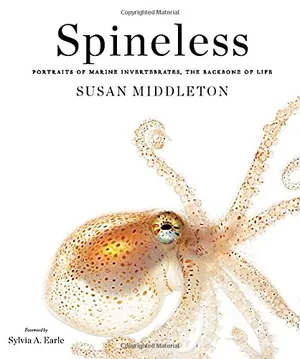
Spineless


/https://tf-cmsv2-smithsonianmag-media.s3.amazonaws.com/filer/60/29/60291d79-9489-4eb8-ab87-a229e095bd1e/42-26609536.jpg)
